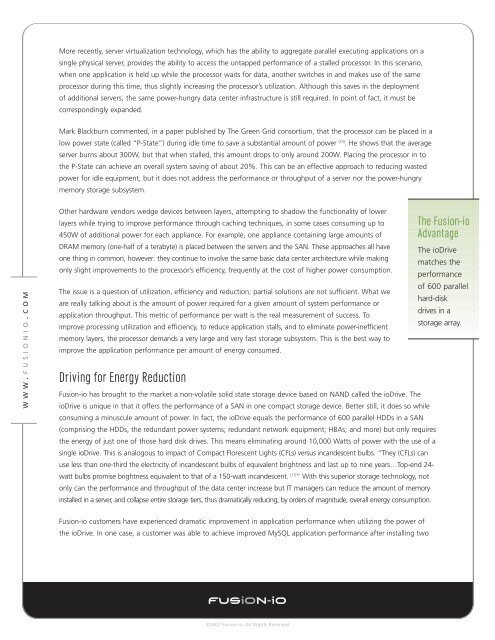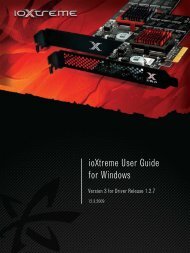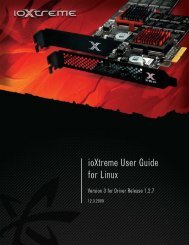Taming the Power Hungry Data Center - Fusion-io
Taming the Power Hungry Data Center - Fusion-io
Taming the Power Hungry Data Center - Fusion-io
Create successful ePaper yourself
Turn your PDF publications into a flip-book with our unique Google optimized e-Paper software.
More recently, server virtualizat<strong>io</strong>n technology, which has <strong>the</strong> ability to aggregate parallel executing applicat<strong>io</strong>ns on a<br />
single physical server, provides <strong>the</strong> ability to access <strong>the</strong> untapped performance of a stalled processor. In this scenar<strong>io</strong>,<br />
when one applicat<strong>io</strong>n is held up while <strong>the</strong> processor waits for data, ano<strong>the</strong>r switches in and makes use of <strong>the</strong> same<br />
processor during this time, thus slightly increasing <strong>the</strong> processor’s utilizat<strong>io</strong>n. Although this saves in <strong>the</strong> deployment<br />
of addit<strong>io</strong>nal servers, <strong>the</strong> same power-hungry data center infrastructure is still required. In point of fact, it must be<br />
correspondingly expanded.<br />
Mark Blackburn commented, in a paper published by The Green Grid consortium, that <strong>the</strong> processor can be placed in a<br />
low power state (called “P-State”) during idle time to save a substantial amount of power [13] . He shows that <strong>the</strong> average<br />
server burns about 300W, but that when stalled, this amount drops to only around 200W. Placing <strong>the</strong> processor in to<br />
<strong>the</strong> P-State can achieve an overall system saving of about 20%. This can be an effective approach to reducing wasted<br />
power for idle equipment, but it does not address <strong>the</strong> performance or throughput of a server nor <strong>the</strong> power-hungry<br />
memory storage subsystem.<br />
WWW. FUSIONIO. COM<br />
O<strong>the</strong>r hardware vendors wedge devices between layers, attempting to shadow <strong>the</strong> funct<strong>io</strong>nality of lower<br />
layers while trying to improve performance through caching techniques, in some cases consuming up to<br />
450W of addit<strong>io</strong>nal power for each appliance. For example, one appliance containing large amounts of<br />
DRAM memory (one-half of a terabyte) is placed between <strong>the</strong> servers and <strong>the</strong> SAN. These approaches all have<br />
one thing in common, however: <strong>the</strong>y continue to involve <strong>the</strong> same basic data center architecture while making<br />
only slight improvements to <strong>the</strong> processor’s efficiency, frequently at <strong>the</strong> cost of higher power consumpt<strong>io</strong>n.<br />
The issue is a quest<strong>io</strong>n of utilizat<strong>io</strong>n, efficiency and reduct<strong>io</strong>n; partial solut<strong>io</strong>ns are not sufficient. What we<br />
are really talking about is <strong>the</strong> amount of power required for a given amount of system performance or<br />
applicat<strong>io</strong>n throughput. This metric of performance per watt is <strong>the</strong> real measurement of success. To<br />
improve processing utilizat<strong>io</strong>n and efficiency, to reduce applicat<strong>io</strong>n stalls, and to eliminate power-inefficient<br />
memory layers, <strong>the</strong> processor demands a very large and very fast storage subsystem. This is <strong>the</strong> best way to<br />
improve <strong>the</strong> applicat<strong>io</strong>n performance per amount of energy consumed.<br />
Driving for Energy Reduct<strong>io</strong>n<br />
<strong>Fus<strong>io</strong>n</strong>-<strong>io</strong> has brought to <strong>the</strong> market a non-volatile solid state storage device based on NAND called <strong>the</strong> <strong>io</strong>Drive. The<br />
<strong>io</strong>Drive is unique in that it offers <strong>the</strong> performance of a SAN in one compact storage device. Better still, it does so while<br />
consuming a minuscule amount of power. In fact, <strong>the</strong> <strong>io</strong>Drive equals <strong>the</strong> performance of 600 parallel HDDs in a SAN<br />
(comprising <strong>the</strong> HDDs, <strong>the</strong> redundant power systems; redundant network equipment; HBAs; and more) but only requires<br />
<strong>the</strong> energy of just one of those hard disk drives. This means eliminating around 10,000 Watts of power with <strong>the</strong> use of a<br />
single <strong>io</strong>Drive. This is analogous to impact of Compact Florescent Lights (CFLs) versus incandescent bulbs. “They (CFLs) can<br />
use less than one-third <strong>the</strong> electricity of incandescent bulbs of equivalent brightness and last up to nine years…Top-end 24-<br />
watt bulbs promise brightness equivalent to that of a 150-watt incandescent. [17] ” With this super<strong>io</strong>r storage technology, not<br />
only can <strong>the</strong> performance and throughput of <strong>the</strong> data center increase but IT managers can reduce <strong>the</strong> amount of memory<br />
installed in a server, and collapse entire storage tiers, thus dramatically reducing, by orders of magnitude, overall energy consumpt<strong>io</strong>n.<br />
The <strong>Fus<strong>io</strong>n</strong>-<strong>io</strong><br />
Advantage<br />
The <strong>io</strong>Drive<br />
matches <strong>the</strong><br />
performance<br />
of 600 parallel<br />
hard-disk<br />
drives in a<br />
storage array.<br />
<strong>Fus<strong>io</strong>n</strong>-<strong>io</strong> customers have experienced dramatic improvement in applicat<strong>io</strong>n performance when utilizing <strong>the</strong> power of<br />
<strong>the</strong> <strong>io</strong>Drive. In one case, a customer was able to achieve improved MySQL applicat<strong>io</strong>n performance after installing two<br />
©2007 <strong>Fus<strong>io</strong>n</strong>-<strong>io</strong>, All Rights Reserved.















